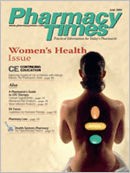OTC Therapies for Allergic Rhinitis
It is that time of year again. Pollen counts are on the rise, causing some patients to stay indoors. Pharmacists will play a vital role in the care of these patients, because they come to their pharmacists for advice when they are experiencing signs and symptoms of allergic rhinitis. Pharmacists should be prepared when they hear a loud, continuous "achoo?achoo?achoo?" in Aisle 5.
Seasonal Versus Perennial Allergic Rhinitis
Whether it is seasonal or perennial, allergic rhinitis affects approximately 16% of the US population. Seasonal allergic rhinitis typically results from exposure to weed pollen, trees, or grass. With this type of rhinitis, symptoms tend to decrease with the arrival of cold weather.
Perennial allergic rhinitis, however, may cause symptoms year-round. This reaction is usually the result of indoor irritants such as mold spores, dust mites, cigarette smoke, animal dander, and various chemicals.
Pathophysiology
Allergic rhinitis commonly is associated with a histamine reaction that causes itching, sneezing, and pain. Histamine is not the sole contributor, however. Sensory neural stimulation causes nasal itch and rhinorrhea. Kinins, prostaglandins, and leukotrienes induce nasal blockage. Finally, granulocytes generate an inflammatory response.
Symptoms
Common symptoms include sneezing; itchy, red, watery eyes; runny nose; and nasal congestion. Patients also may experience nausea, poor appetite, fatigue, headaches, and some difficulty in smelling or hearing.
Nonpharmacologic Treatment Options
An allergy cannot be prevented, but steps can be taken to prevent a reaction. The most effective way to prevent a reaction from occurring is to avoid the allergen that triggers the response. Here are some steps for pharmacists to tell patients to take:
- For patients who are allergic to warm-blooded animals, try to confine the pet to another room in the house. It is very important to keep pets out of the bedroom. If it is not possible, you may have to consider giving the pet away.
- Try to avoid pollen by rescheduling or limiting your outdoor activities. Pollen counts are highest between 5 AM and 10 AM and on dry, hot, windy days. Otherwise, use precautions such as wearing a mask, using air-conditioning, and keeping doors and windows closed.
- Make sure that your house (especially the bedroom) is as allergyfree as possible: Frequently clean all bedding, carpeting (never sweep, always vacuum), blinds, and curtains Use pillows and comforters stuffed with polyester (not feathers) Enclose mattresses and box springs in plastic Move out all unnecessary furniture Avoid stuffed animals and decorative pillows Use a high-efficiency particulate air filter, especially in the sleeping area
Other tips for pharmacists to give patients to increase their comfort and decrease the severity of the allergic reaction include the following:
- Sleep with your head elevated to prevent nasal congestion
- Drink adequate fluids-at least eight 8-oz glasses per day-to loosen secretions
- Exercise regularly
- Maintain a balanced diet; doing so will improve your body's ability to heal itself
OTC Treatment Options
Pharmacotherapy generally is symptom-specific and depends on the severity of illness. Antihistamines typically are indicated for the itching, sneezing, and rhinorrhea associated with allergic rhinitis. Side effects of antihistamines may vary, based on product selection, but commonly include dry eyes, blurred vision, urinary retention, dry mouth, constipation, and sedation. All first-generation antihistamines are sedating, but the alkylamines (chlorpheniramine, pheniramine, and brompheniramine) are the least sedating, and the ethanolamines (doxylamine, diphenhydramine, and phenyltoloxamine) are the most sedating. It is important to note that children and older adults may experience paradoxical excitement when taking antihistamines (Table 1).
Decongestants are used for the temporary relief of nasal congestion. The nonprescription decongestants come in 2 dosage formulations, systemic and topical. Although topical products are convenient, patients should be counseled to limit use to 3 to 5 days in order to prevent rebound congestion. Side effects of decongestants include an increase in blood pressure, restlessness, anxiety, tremors, palpitation, and insomnia (Table 2).
Dr. Jackson is a community pharmacy resident with the University of North Carolina at Chapel Hill School of Pharmacy and Kerr Drug Pharmacies. Dr. Ferreri is a clinical assistant professor at the University of North Carolina at Chapel Hill School of Pharmacy.

